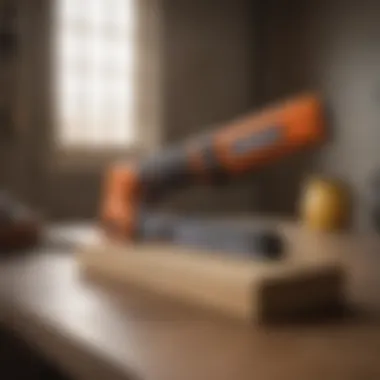Top Small Sawzalls Reviewed: Features and Benefits


Overview of Topic
In recent years, small sawzalls have evolved into essential tools for homeowners and DIY enthusiasts alike. These compact, versatile saws are crucial for a variety of tasks, including remodeling, plumbing, and even intricate woodworking projects. Small sawzalls, often referred to as reciprocating saws, allow for precision cutting in tight spaces where traditional saws may struggle.
Understanding the features and capabilities of these saws is vital for any homeowner. With the right small sawzall, tasks like cutting through drywall or trimming branches can be completed efficiently and effectively. Their importance is underscored by how they simplify challenging projects, allowing individuals to take on tasks that may have seemed daunting.
Common Challenges and Solutions
Homeowners encounter several challenges when working with small sawzalls. Some common issues include:
- Choosing the Right Blade: Selecting an appropriate blade for the material can be overwhelming given the numerous options available.
- Battery Life: For cordless models, battery life can be a concern. Users often find themselves interrupted by the need to recharge.
- Control and Precision: Smaller saws can sometimes lack the power for tougher jobs, resulting in frustrating experiences.
Solutions and Tips
To overcome these challenges, consider the following:
- Invest in Quality Blades: Research and invest in blades designed specifically for the materials you plan to cut.
- Buy Extra Batteries: If you choose a cordless saw, purchasing additional batteries can ensure your work is uninterrupted.
- Practice Maneuvering: Spend time practicing with the saw on scrap materials. This can help improve control and enhance precision.
Product Recommendations
Certain brands stand out in the small sawzall market owing to their reliability and performance. A few noteworthy options include:
- Milwaukee M12 Fuel Hackzall: Renowned for its power and portability, it excels in both light and heavy-duty applications. Key features include a brushless motor and variable speed.
- DeWalt DCS367B: This model offers excellent battery life and is compatible with a range of blades. The ergonomic design enhances user experience and comfort.
- Bosch GSA18V-083B: Known for its low vibration, this saw ensures less fatigue during prolonged use. It's lightweight and easy to maneuver.
Each of these products provides unique benefits that cater to different needs. Careful consideration of their features can aid in making an informed choice.
Step-by-Step Guides
Once you've chosen a small sawzall that meets your requirements, it’s time to put it to use. Here’s a practical guide to help you get started:
- Gather Your Materials: Ensure you have the right blade, safety gear, and the material you plan to cut.
- Prepare the Workspace: Clear any debris and ensure a stable surface to work on.
- Select the Appropriate Speed: Depending on your saw model, set the appropriate speed based on the material's thickness and type.
- Position the Saw: Hold the saw firmly and align the blade with your cutting line. For more curved cuts, it’s helpful to work slowly.
- Start Cutting: Activate the saw and apply gentle pressure as you cut through the material. Keep an eye on your blade position while cutting.
- Finish and Clean Up: Once done, turn off the saw. Safely remove any waste material to ensure a clean workspace.
By following these steps, you are positioned to achieve successful and accurate results. Remember to maintain your tools after each use to prolong their life and maintain efficiency.
"Investing time in learning about your tools can save you time in your projects."
This comprehensive approach equips you with the necessary knowledge to properly choose and utilize small sawzalls effectively.
Foreword to Small Sawzalls
The discussion around small sawzalls is an essential one for both housewives and homeowners alike, especially those who take on DIY projects or renovations. A small sawzall, also known as a reciprocating saw, offers versatility in cutting different materials, including wood, metal, and plastic. Understanding the nuances of these tools allows individuals to choose the right one for their specific needs. This section will provide a framework for grasping what small sawzalls are and why they matter in home improvement tasks.
Definition and Overview
A small sawzall is a compact tool designed to make quick and precise cuts in various materials. Ideal for tight spaces, this tool features a straight blade that moves back and forth, allowing users to make intricate cuts without excessive force or movement. The size of the sawzall contributes to its maneuverability, making it accessible for both beginners and seasoned DIY enthusiasts.
For homeowners, having a small sawzall can simplify projects, from basic repairs to more extensive renovation tasks. Key benefits include ease of use, portability, and the capability to handle a range of cutting tasks. It can be particularly useful for those who may not have the physical strength necessary for larger saws, thereby making home maintenance more achievable.
Evolution of the Sawzall
The origins of the sawzall date back to the 1950s when they were first introduced as corded electric tools. Over the years, significant evolution has taken place, adapting to user needs and technological advances. The early models were bulky and primarily used by professionals in construction or demolition. However, with the rise of the DIY culture, manufacturers began to downsize these tools.
Today's small sawzalls come in both corded and cordless options, allowing users to choose one that aligns with their preferences and requirements. Improvements in battery technology have also made cordless models more popular, offering convenience without sacrificing power.
Innovations in blade design and materials have contributed to the versatility of small sawzalls, enabling them to cut through a variety of materials with ease. These developments reflect a growing recognition of the tool's value in everyday home projects. Understanding these advancements is crucial for individuals looking to invest in a small sawzall that will effectively serve their needs.


Key Features of Small Sawzalls
Understanding the key features of small sawzalls is essential for anyone considering this tool. It informs potential buyers about what to look out for based on their unique needs. Small sawzalls combine portability with efficiency, making them suitable for a variety of tasks from DIY home projects to professional use. Important aspects include how easy they are to handle, the power source they utilize, and the types of blades available. This exploration helps users make informed choices tailored to their individual projects and preferences.
Portability and Weight Considerations
Portability is a crucial factor when choosing a small sawzall. Homeowners and hobbyists often require tools that are easy to transport. A lightweight design allows for extended use without fatigue. Moreover, small sawzalls that are compact can easily fit into tight spaces. Many users appreciate the ease with which they can store these tools when not in use, occupying minimal space in a garage or toolbox.
When selecting a sawzall, consider your typical usage scenarios. If you frequently work in different locations, a portable model will save you time and energy. Weight also impacts control and accuracy during operation, influencing the quality of your cuts. In short, lightweight and portable designs enhance the practicality of small sawzalls.
Power Source Variations
Power source is a significant category to consider when evaluating small sawzalls. Users generally have two options: battery-powered or corded models. These provide different benefits that can suit varying project requirements. Each option comes with its own characteristics and ideal use cases.
Battery-Powered vs Corded
Battery-powered sawzalls offer the advantage of flexibility. The absence of cords means users can operate them far from power outlets, enhancing mobility. Many modern battery models feature lithium-ion cells, which maintain their performance over a range of usages and conditions.
On the other hand, corded sawzalls provide unlimited runtime. This ensures that users can work on large projects without interruption. If you regularly require sustained power and performance without recharge times, corded versions may be more appealing. However, the limitation of movement caused by cords must be kept in mind when considering options. Both types have strong merits, making them suitable for different environments and needs.
Runtime and Charging Time
Runtime and charging time are critical factors for battery-powered sawzalls. A tool that can operate for extended periods without needing a recharge enhances productivity. In addition, fast charging technology allows users to minimize downtime. Many customers seek specifications that detail how long the sawzall can run before requiring a charge and the time it takes to regain full power.
A good balance can make all the difference. Some models claim to operate effectively for several hours, making them strong choices for users needing endurance. However, it’s important to consider trade-offs, as models with longer runtime often weigh more due to larger batteries. Careful evaluation of these aspects will help determine the best choice for your specific circumstances.
Blade Options and Compatibility
The variety of blades available for small sawzalls significantly impacts functionality. Compatibility with different blade types enables users to tackle various materials. Users should consider blade types such as wood, metal, or specialty options for unique tasks. This versatility ensures that a single tool can function effectively in diverse situations.
Understanding the specifications for blade length and attachment mechanisms is also key. Many sawzalls feature tool-less blade changes, enhancing user experience by allowing quick swaps. When selecting a small sawzall, ensure that it is compatible with the blades you plan to use frequently, maximizing the tool's utility for your projects.
In summary, the key features of small sawzalls encompass various considerations that affect usability and efficiency. By examining portability, power sources, and blade options, potential buyers can better understand what fits their needs.
Performance Metrics
Performance metrics are crucial when evaluating the effectiveness of small sawzalls. These metrics provide insights into how a tool performs under different conditions and tasks. By analyzing cutting speed, efficiency, vibration control, and operator safety, homeowners and housewives can select a tool that fits their specific needs. Understanding these aspects ensures that the chosen small sawzall not only meets performance expectations but also aligns with safety and usability standards.
Cutting Speed and Efficiency
Cutting speed refers to how quickly a saw can make cuts through material. For small sawzalls, this is especially significant. A higher cutting speed increases productivity, allowing users to accomplish more tasks in less time. Efficiency, on the other hand, encompasses how effectively the tool converts power into performance without wasting energy.
- Factors Influencing Cutting Speed
Several elements can affect cutting speed:
- Amperage: Tools with higher amperage typically deliver more power, resulting in faster cuts.
- Blade Type: Different blades are designed for various materials. Selecting the correct blade enhances cutting speed.
- Stroke Rate: A higher stroke rate often translates into faster cuts, making this a critical factor to consider when choosing a small sawzall.
Moreover, efficiency is not solely about speed. It largely involves how well the tool performs over extended use. Users should consider tools that maintain performance without overheating or losing cutting power, as this increases the lifespan of both the sawzall and its blades.
"Selecting a tool with optimal cutting speed can significantly reduce the time spent on home projects."
Vibration Control and Operator Safety
Vibration control is a key aspect of using a power tool. Excessive vibrations can not only lead to discomfort but also cause injury over time. Tools equipped with effective vibration damping systems extend safe usage periods. This is particularly relevant for small sawzalls, where precision and comfort during operation are necessary.
- Importance of Vibration Control


- Reducing Fatigue: High vibration levels can cause fatigue, making it harder to control the tool.
- Enhanced Accuracy: When vibrations are minimized, users can focus better on their cuts, improving overall accuracy.
In addition to vibration control, safety features such as trigger locks, ergonomic designs, and safety guards are essential. These features not only protect the user but also enhance the overall cutting experience.
Evaluating performance metrics allows users to gain a better understanding of how a small sawzall can make their projects easier and more efficient. It encourages safe practices and promotes effective usage of the tool, benefits that ultimately contribute to a successful home improvement endeavor.
Best Small Sawzalls on the Market
The choice of a small sawzall can have a significant impact on various tasks, whether it is home projects or professional jobs. In this section, we will delve into some of the top contenders available in the market, analyzing their features, user feedback, and cost considerations. This comprehensive review will assist readers in making informed decisions by comparing the strengths and weaknesses of each product.
Product Reviews: Top Contenders
Product A - Features and Performance
One notable small sawzall in the market is the Milwaukee M12 Hackzall. It is well-known for its compact size and powerful performance. The tool features a brushless motor that provides efficient cutting with less vibration.
One key characteristic is its lightweight design, making it quite portable and easy to handle, especially for overhead cuts. The unique feature of the Milwaukee Hackzall is its one-handed operation, which facilitates tasks in tight spaces. The blade changes are also tool-free, saving time and effort.
Advantages of this product include its lightweight nature and powerful motor, while the disadvantage may be the shorter battery life compared to other models. Overall, it remains a popular choice due to its efficiency and design.
Product B - User Experience
Next in line is the DeWalt DCS367B. This model has gained attention specifically for its user-friendly experience. Users frequently highlight its adjustable blade speed, allowing for customization based on the material being cut.
One shining feature of this sawzall is its LED light, which provides visibility in dim working conditions. This is beneficial for users who work in basements or poorly lit areas. Its ergonomic grip also contributes to a more comfortable working experience.
However, some users have noted that the tool can feel heavier during prolonged use. Despite this, the combination of features makes it a strong contender for those who prioritize user experience.
Product - Cost Analysis
The last product we will review is the Ryobi P514. This sawzall stands out due to its cost-effectiveness while still delivering decent performance. The pricing is attractive for homeowners who do not want to overspend but still need a reliable tool.
Its key characteristic is the versatility it offers with a variety of compatible blades for different cutting tasks. Users appreciate the dual-speed feature, which helps adapt to various materials.
The downside of the Ryobi P514 is its heavier design compared to other products. This can affect portability and ease of use in tight spaces. Nevertheless, for those on a budget, it presents itself as an excellent value.
Comparison of Specifications
A clear comparison of specifications can make it easier to identify the best small sawzall for your needs. Consider the following aspects when making your decision:
- Power Type: Battery-powered vs Corded. Some users prioritize the convenience of battery-powered tools, while others prefer the uninterrupted power of corded models.
- Speed Settings: Adjustable blade speeds allow better customization according to material.
- Weight: Heavier models can provide more durability but may be less portable.
- Price: Consider your budget and what you get for your money.
Ultimately, comparing these specifications helps tailor the choice according to specific needs, ensuring that the selected sawzall aligns well with user expectations.
„The best tool for the job is the one that makes you feel most comfortable in your work.“
By understanding the features and specifications, readers can select the right small sawzall that meets their unique requirements.
User Considerations
User considerations are crucial when selecting a small sawzall. This part of the analysis goes beyond mere specifications; it delves into what you actually need from the tool. Understanding your own requirements will prevent overspending and ensure that the tool you select performs adequately for your intended tasks.
Identifying Your Needs
When looking for a small sawzall, the first step is to clearly identify your needs. Are you a homeowner requiring a tool for minor renovations, or do you need one for more frequent and demanding projects? For those with lighter tasks like cutting wood for DIY projects, a battery-powered model may suffice. If you often engage in heavy-duty jobs, a corded sawzall may offer more consistent power.


Also consider the type of materials you plan to cut. Certain blades work better with specific materials. For instance, if your projects frequently involve metal, select a sawzall that supports metal-cutting blades. Furthermore, think about the frequency of use. Occasional users may prioritize portability, while professionals may focus on durability and performance.
Budget and Cost Analysis
Budget is a significant factor in purchasing any tool, and small sawzalls are no exception. Prices can vary widely based on brand, features, and performance. Generally, a quality sawzall will range from $50 to $300.
"Understanding your budget can help you choose a sawzall that balances quality and affordability."
When analyzing costs, consider the long-term expenses associated with ownership. For example, purchasing cheaper models may lead to more frequent replacements. This can incur higher costs over time. Additionally, some brands may offer warranties or customer service options that can save money in repairs or replacements.
To narrow down your options, make a list of features that are non-negotiable for you, and compare different models within your budget. This process ensures that you are not only considering the initial price but also examining the total cost of ownership over time.
By carefully considering your specific needs and budget, you will select a small sawzall that is both effective and cost-efficient for your unique circumstances.
Maintenance and Care
Maintenance and care are crucial aspects to consider when using a small sawzall. Proper maintenance ensures that the tool operates efficiently, enhances its lifespan, and guarantees the safety of the user. A well-maintained sawzall can save you time and money in the long run by reducing the need for repairs and replacements. When you own a small sawzall, understanding how to care for it is essential for achieving the best results in your projects.
Basic Maintenance Practices
To maintain a small sawzall effectively, several basic practices should be observed.
- Cleaning: After each use, it is important to clean the sawzall to prevent dust and debris from accumulating. Wipe down the exterior with a soft cloth and use compressed air to blow out any dust from the motor and vents.
- Blade Inspection: Regularly check the condition of the blade. Dull blades can cause strain on the motor and affect cutting performance. Replace blades that show signs of wear or damage timely.
- Lubrication: Some sawzalls may require lubrication in their moving parts. Consult the user manual to determine if your model needs lubrication and apply the suitable product if necessary.
- Storage: When not in use, store the sawzall in a dry and secure place. Ideally, use a dedicated case to prevent damage and keep it away from moisture, which can lead to rust.
Implementing these practices can significantly extend the life of your small sawzall.
Troubleshooting Common Issues
Despite careful maintenance, issues may still arise with your small sawzall. Here are some common problems and their potential solutions:
- Motor Won't Start: If the sawzall does not power on, check the power source. Ensure the battery is charged if it’s battery-operated, or plug it into a functioning outlet if it’s corded. Inspect the power cord for any signs of damage.
- Excessive Vibration: Vibration during operation can indicate that the blade is loose or damaged. Ensure the blade is properly installed and tight. If the problem persists, try using a new blade.
- Overheating: If the tool becomes hot to the touch, it may be overworked. Allow it to cool down and avoid applying too much pressure during use. Check the vents for any obstructions that may hinder airflow.
- Poor Cutting Performance: If the sawzall struggles with cuts, inspect the blade. A dull or incompatible blade may be the cause. Replacing it with the correct type is advisable.
By identifying and addressing these issues promptly, you can maintain the performance of your small sawzall effectively.
"Regular maintenance not only prolongs the life of tools but also enhances safety during usage. Follow basic care and troubleshooting tips to ensure optimal performance."
Culmination and Final Thoughts
In evaluating the best small sawzalls, it becomes evident that a thorough understanding of these tools is essential. This article serves as a guide to help users, particularly housewives and homeowners, navigate their options effectively.
Choosing the right sawzall involves various factors that are specific to individual needs. Understanding the unique features, performance metrics, and maintenance practices discussed in earlier sections helps in making an informed decision. It is crucial for homeowners to assess their requirements, whether they need a compact tool for household tasks or a more robust sawzall for heavier projects.
Moreover, maintaining the tool with appropriate care directly impacts its longevity and effectiveness. Familiarity with routine maintenance and troubleshooting can save time and increase productivity. Likewise, awareness of future design trends may provide insights into evolving technologies that can enhance user experience.
"Selecting the right tool is as important as knowing how to use it effectively."
This encapsulates the significance of the research undertaken in this article. By considering the specific elements, benefits, and overall considerations presented, homeowners can find a small sawzall that not only fits their practical needs but also elevates their project outcomes.
Summary of Key Findings
In summary, the following key points highlight the strengths of the small sawzall:
- Portability: These tools are easier to handle, making them ideal for various tasks.
- Versatile power sources: Options include corded and battery-operated, allowing users to select based on their preferences.
- Wide range of blade compatibility: Ensure that users can choose the right blade for their specific cutting tasks.
Future Trends in Small Sawzall Design
Looking ahead, several trends in the design of small sawzalls are evident. Innovations focus on enhancing battery life, improving lightweight materials, and integrating smarter technology.
For example, developments in lithium battery technology promise longer run times and faster charging, addressing a common concern for users of battery-powered sawzalls. Moreover, advancements in vibration control not only improve the user experience but also enhance safety during operation.
Intelligent features, such as adjustable speed settings or built-in sensors for real-time feedback on cutting effectiveness, are gaining traction. This trend towards smarter, more efficient tools will likely become a defining characteristic of future models.
By staying informed about such developments, homeowners can make purchases that align with their current needs and anticipate evolving functionalities.







